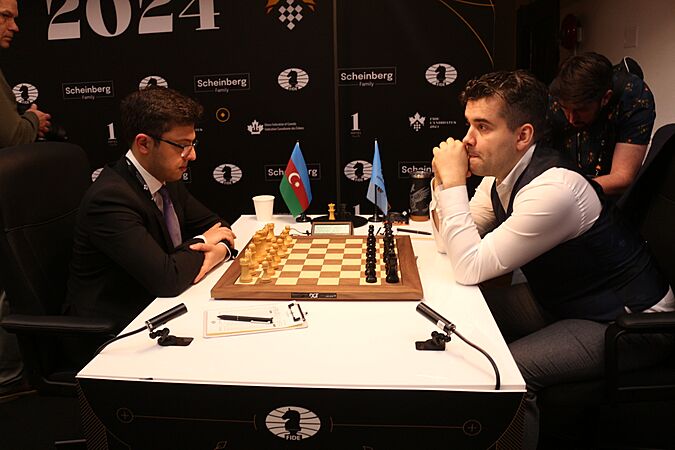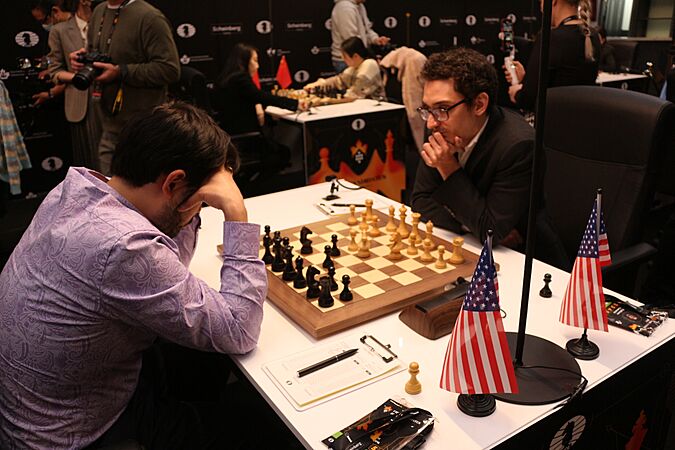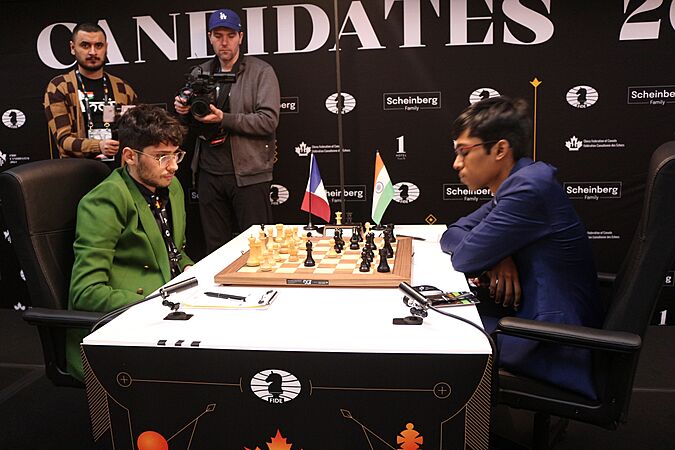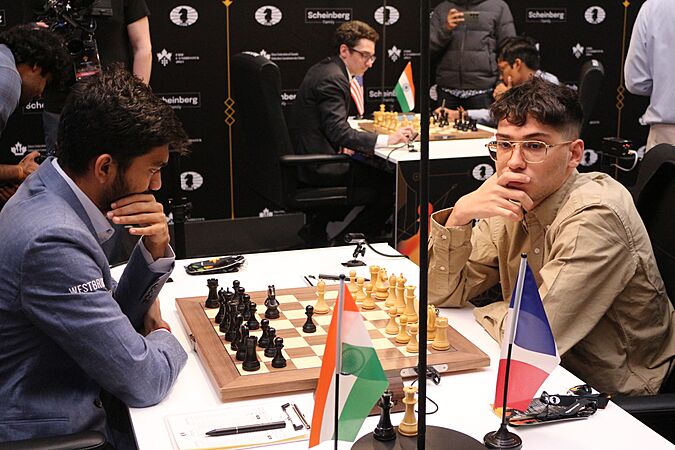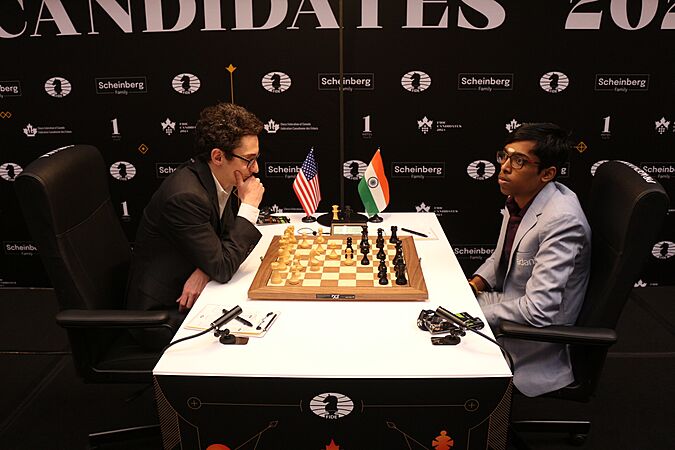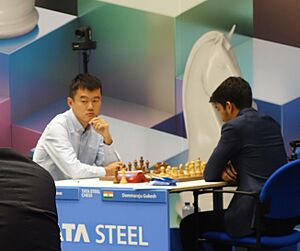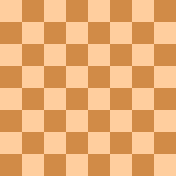World Chess Championship 2024 facts for kids
| Resorts World Sentosa, Singapore | ||||||||||||||||||||||||||||||||||||||||||||||||||||||||||||||||
| 25 November – 12 December 2024 | ||||||||||||||||||||||||||||||||||||||||||||||||||||||||||||||||
|
Defending champion
|
Challenger |
|||||||||||||||||||||||||||||||||||||||||||||||||||||||||||||||
 |
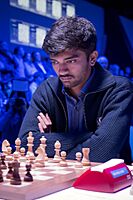 |
|||||||||||||||||||||||||||||||||||||||||||||||||||||||||||||||
|
||||||||||||||||||||||||||||||||||||||||||||||||||||||||||||||||
| Born 24 October 1992 32 years old |
Born 29 May 2006 18 years old |
|||||||||||||||||||||||||||||||||||||||||||||||||||||||||||||||
| Winner of the World Chess Championship 2023 | Winner of the Candidates Tournament 2024 | |||||||||||||||||||||||||||||||||||||||||||||||||||||||||||||||
| Rating: 2728 (World No. 23) |
Rating: 2783 (World No. 5) |
|||||||||||||||||||||||||||||||||||||||||||||||||||||||||||||||
|
|
||||||||||||||||||||||||||||||||||||||||||||||||||||||||||||||||
The World Chess Championship 2024 was a big chess match. It decided who would be the new World Chess Champion. The match was between the champion, Ding Liren, and the challenger, Gukesh Dommaraju.
It happened in Singapore from November 25 to December 12, 2024. They played up to 14 games. If the score was tied, they would play faster tiebreak games.
Ding Liren won the 2023 World Chess Championship. He became champion after Magnus Carlsen decided not to defend his title. Gukesh earned the right to challenge Ding. He won the Candidates Tournament in April 2024.
Before the match, Gukesh was ranked 5th in the world. His Elo rating was 2783. Ding was ranked 23rd with an Elo rating of 2728. Gukesh won the match 7½ to 6½ after 14 games. This made him the youngest ever World Chess Champion! Ding won two games, and Gukesh won three. Gukesh won the final game, and the match, when Ding made a mistake.
Contents
- Meet the Champion: Ding Liren
- The Challenger: Gukesh Dommaraju
- Who Qualified for the Tournament?
- How the Tournament Was Organized
- Tournament Results
- Images
- See also
- The Championship Match
- Match Results
- Classical Games
- Game 1: Gukesh vs. Ding, Ding Wins
- Game 2: Ding vs. Gukesh, Draw
- Game 3: Gukesh vs. Ding, Gukesh Wins
- Game 4: Ding vs. Gukesh, Draw
- Game 5: Gukesh vs. Ding, Draw
- Game 6: Ding vs. Gukesh, Draw
- Game 7: Gukesh vs. Ding, Draw
- Game 8: Ding vs. Gukesh, Draw
- Game 9: Gukesh vs. Ding, Draw
- Game 10: Ding vs. Gukesh, Draw
- Game 11: Gukesh vs. Ding, Gukesh Wins
- Game 12: Ding vs. Gukesh, Ding Wins
- Game 13: Gukesh vs. Ding, Draw
- Game 14: Ding vs. Gukesh, Gukesh Wins
- Classical Games
Meet the Champion: Ding Liren
Ding Liren became the World Chess Champion in April 2023. He won by beating Ian Nepomniachtchi. After winning, Ding took a break from playing in big tournaments for several months. He later said he needed to rest and feel better.
Ding returned to playing chess in January 2024. He played in the 2024 Tata Steel Chess Tournament. He said he still wanted to defend his world title.
However, Ding did not play his best when he returned. His rating dropped from 2788 to 2728. His world ranking also fell from 3rd to 23rd. Other chess experts like Fabiano Caruana and Magnus Carlsen worried about his form. Ding himself admitted that Gukesh was playing very well. He said Gukesh might be the favorite for the match.
The Challenger: Gukesh Dommaraju
Gukesh Dommaraju became the challenger by winning the Candidates Tournament 2024. This tournament took place in Toronto, Canada. Eight players competed in a double round-robin format. This means everyone played each other twice.
Gukesh qualified for the Candidates Tournament by doing well in the 2023 FIDE Circuit. He won the Chennai Grand Masters tournament to secure his spot.
Here are the players who competed in the Candidates Tournament:
| How they qualified | Player | Age | Rating | World ranking |
|---|---|---|---|---|
| (April 2024) | ||||
| 2023 World Championship runner-up | 33 | 2758 | 7 | |
| Top three from the Chess World Cup 2023 | 33 | 2830 | 1 | |
| 18 | 2747 | 14 | ||
| 31 | 2803 | 2 | ||
| 28 | 2632 | 114 | ||
| Top two from the FIDE Grand Swiss Tournament 2023 | 29 | 2727 | 25 | |
| 36 | 2789 | 3 | ||
| Highest in the 2023 FIDE Circuit not already qualified | 17 | 2743 | 16 | |
| Highest rating for January 2024 not already qualified | 20 | 2760 | 6 | |
Candidates Tournament Results
| Candidates Tournament 2024 | |
|---|---|
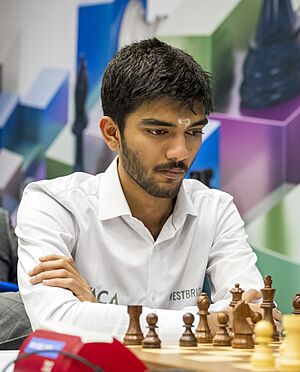
Gukesh Dommaraju, the winner of the tournament, advanced to the World Chess Championship 2024 match.
|
|
| Venue | The Great Hall |
| Location | Toronto, Canada |
| Dates | 3–22 April 2024 |
| Competitors | 8 from 5 nations |
| Winning score | 9 points of 14 |
| Champion | |
The 2024 Candidates Tournament was a big chess competition. Eight top players battled it out to decide who would challenge the current World Chess Champion, Ding Liren. This exciting event happened in Toronto, Canada, from April 3 to April 22, 2024.
It was held at The Great Hall and took place at the same time as the Women's Candidates Tournament 2024. The winner was Gukesh Dommaraju from India. He made history by becoming the youngest ever winner of a Candidates Tournament. This also made him the youngest player to ever challenge for the World Chess Championship title!
Like other Candidates tournaments since 2013, this one was a double round-robin. This means each player played against every other player twice. Once they played with the white pieces, and once with the black pieces. The player who scored the most points won the tournament.
Who Qualified for the Tournament?
To play in the Candidates Tournament, chess players had to qualify through different major events. Here's how the eight players earned their spots:
| Qualification method | Player | Age | Rating | World ranking |
|---|---|---|---|---|
| 2023 World Championship runner-up | 33 | 2758 | 7 | |
| The top three finishers in the Chess World Cup 2023 | 18 | 2747 | 14 | |
| 31 | 2803 | 2 | ||
| 28 | 2632 | 114 | ||
| The top two finishers in the FIDE Grand Swiss Tournament 2023 | 29 | 2727 | 25 | |
| 36 | 2789 | 3 | ||
| Highest place in the 2023 FIDE Circuit | 17 | 2743 | 16 | |
| Highest rating for January 2024 | 20 | 2760 | 6 |
Why Magnus Carlsen Didn't Play
Magnus Carlsen, a former World Champion, won the Chess World Cup 2023. This meant he qualified for the Candidates Tournament. However, he decided not to play in Toronto. He had said before that he didn't enjoy the Candidates format.
In January 2024, Carlsen officially confirmed he wouldn't play. He simply stated, "I would say the main reason is that I don't enjoy it." Because Carlsen didn't play, Nijat Abasov, who finished fourth in the World Cup, took his place in the tournament.
How the Rating Spot Was Decided
One spot in the Candidates Tournament went to the player with the highest rating in January 2024. This was for players who hadn't qualified yet and had played in at least four FIDE chess events.
This spot became a bit of a race! Alireza Firouzja was a top contender. After some games, he lost rating points. To get his rating back up, he played some special matches in France. These matches were called "Alireza Firouzja's Race to Candidates." He needed to win many games to qualify.
There was some discussion about these last-minute games. Other players and chess organizations wondered if it was fair. However, Firouzja kept playing. He eventually won another tournament, the Open de Rouen, which gave him enough rating points. So, he officially qualified for the Candidates Tournament by rating.
How the Tournament Was Organized
The tournament was a double round-robin, meaning each of the eight players played every other player twice. They played one game with the white pieces and one with the black pieces. The winner earned the chance to play for the World Championship title against Ding Liren.
To make sure everything was fair, players from the same country had to play each other early in the tournament. For example, the Indian players (R Praggnanandhaa, Vidit Gujrathi, and Gukesh Dommaraju) played each other in the first few rounds. The same rule applied to the American players (Fabiano Caruana and Hikaru Nakamura).
The main referee for the event was Aris Marghetis from Canada.
Tournament Rules
The games had a specific time limit. Players had 120 minutes for their first 40 moves. After that, they got an extra 30 minutes for the rest of the game. From move 41, they also got an extra 30 seconds for each move.
- A win gave a player 1 point.
- A draw gave ½ point.
- A loss gave 0 points.
What if There Was a Tie?
If players ended up with the same score for first place, they would play special tie-break games:
- Rapid Chess: They would first play two faster games (15 minutes plus 10 seconds per move).
- Blitz Chess: If still tied, they would play even faster games (3 minutes plus 2 seconds per move).
- Knock-out: If still tied, they would play quick knock-out games until someone won.
For other tied places, different rules like the Sonneborn–Berger score or total wins would decide the ranking.
Prize Money
The total prize money for the tournament was €500,000 (about $530,000 USD).
- First place received €48,000.
- Second place received €36,000.
- Third place received €24,000.
Players also got €3,500 for every half-point they scored.
Tournament Schedule
|
All games started at 2:30 PM local time in Toronto.
Tournament Results
How Players Scored Each Round
This table shows how many more wins than losses each player had after each round. A green background means the player was leading. A red background means they could no longer win the tournament.
| Rank | Player | Rounds | |||||||||||||
|---|---|---|---|---|---|---|---|---|---|---|---|---|---|---|---|
| 1 | 2 | 3 | 4 | 5 | 6 | 7 | 8 | 9 | 10 | 11 | 12 | 13 | 14 | ||
| 1 | = | +1 | +1 | +1 | +2 | +2 | +1 | +2 | +2 | +2 | +2 | +3 | +4 | +4 | |
| 2 | = | −1 | −1 | −1 | = | = | = | +1 | = | +1 | +2 | +3 | +3 | +3 | |
| 3 | = | +1 | +1 | +2 | +2 | +2 | +2 | +2 | +2 | +2 | +3 | +3 | +3 | +3 | |
| 4 | = | +1 | +1 | +1 | +1 | +1 | +1 | = | = | +1 | +1 | +2 | +3 | +3 | |
| 5 | = | −1 | = | = | = | +1 | +1 | +1 | +1 | +1 | = | = | −1 | = | |
| 6 | = | +1 | = | −1 | −1 | = | = | −1 | = | = | −1 | −2 | −2 | −2 | |
| 7 | = | −1 | −1 | −1 | −2 | −3 | −2 | −2 | −2 | −3 | −2 | −3 | −4 | −4 | |
| 8 | = | −1 | −1 | −1 | −2 | −3 | −3 | −3 | −3 | −4 | −5 | −6 | −6 | −7 | |
Tournament Highlights
Before the tournament, many chess experts thought Fabiano Caruana or Hikaru Nakamura would win.
The first round had all draws, but things got exciting in round 2. Vidit Gujrathi beat Nakamura, and Gukesh Dommaraju won against R Praggnanandhaa. Fabiano Caruana also won, and Ian Nepomniachtchi defeated Alireza Firouzja.
In round 3, Praggnanandhaa won the only game, beating Vidit. By round 4, Nepomniachtchi took the lead by winning against Vidit. In round 5, Gukesh joined Nepomniachtchi in the lead after winning his game.
In round 6, Firouzja made a big mistake and lost quickly. Some thought he might be playing too emotionally. In round 7, Firouzja managed to beat Gukesh, which was a surprise. At the halfway point, Nepomniachtchi was still in the lead.
The second half of the tournament started with a big change! In round 8, Gukesh beat Vidit, which put him tied for first place with Nepomniachtchi. Nakamura also won against Caruana.
In round 9, Vidit bounced back and beat Nakamura. The game between Firouzja and Nepomniachtchi was very close, but it ended in a draw. Nakamura and Caruana both won their games in round 10. The game between Gukesh and Nepomniachtchi was a draw, keeping them tied for the lead.
In round 11, Nakamura beat Praggnanandhaa, and Nepomniachtchi won against Vidit. Gukesh and Caruana drew their game. This meant Nepomniachtchi was back in the sole lead.
Round 12 was very important. Nepomniachtchi drew, but Nakamura, Gukesh, and Caruana all won their games. This created a three-way tie for first place between Nepomniachtchi, Nakamura, and Gukesh. Caruana was just half a point behind.
The second-to-last round (round 13) was critical. Gukesh defeated Firouzja, and Caruana beat Praggnanandhaa. Nepomniachtchi and Nakamura drew their game. This gave Gukesh a half-point lead going into the final round!
The final round was full of tension. Nakamura played Gukesh, and Caruana played Nepomniachtchi. Nakamura, Caruana, and Nepomniachtchi all needed to win to catch Gukesh. Gukesh and Nakamura's game ended in a draw. This meant Gukesh had secured at least a tie for first.
The game between Caruana and Nepomniachtchi was very dramatic. Caruana played brilliantly and got a winning position. But Nepomniachtchi defended incredibly well. In the end, Caruana made a small mistake, and Nepomniachtchi managed to get a draw.
With this draw, Gukesh Dommaraju won the tournament! He earned the right to play for the World Chess Championship title against Ding Liren later in 2024.
Images
See also
- Women's Candidates Tournament 2024
The Championship Match
How the Match Was Organized
Countries offered to host the championship. Argentina, India, and Singapore showed early interest. In June 2024, FIDE (the world chess federation) announced three bids. Two were from India, and one was from Singapore.
FIDE chose Singapore to host the match. It took place at the Equarius Hotel in Resorts World Sentosa.
The prize money for the event was US$2.5 million. Each player got US$200,000 for each game they won. The rest of the money was split equally. If there was a tiebreak, the winner would get US$1.3 million and the loser US$1.2 million.
Special guests made the first move of each game. These guests included important people from Google, chess masters, and government officials.
| Game | Guest | |
|---|---|---|
| 1 | Demis Hassabis | Co-founder of Google DeepMind and 2024 Nobel Prize in Chemistry winner |
| 2 | Tan Lian Ann | Singaporean chess master |
| Lim Kok Ann | Singaporean chess player and microbiologist | |
| 3 | Olivier Lim | Chairman of the Singapore Tourism Board |
| 4 | Xie Jun | Women's World Chess Champion (1991–1996; 1999–2001) |
| Viswanathan Anand | Deputy President of FIDE and World Chess Champion (FIDE split title 2000–2002; undisputed champion 2007–2013) | |
| 5 | K. Shanmugam | Minister for Home Affairs and Minister for Law of Singapore |
| 6 | Scott Beaumont | President of Google's operations in the Asia–Pacific region |
| 7 | Edwin Tong | Minister for Culture, Community and Youth and Second Minister for Law of Singapore |
| 8 | Kingston Kwek | Singaporean entrepreneur |
| Goh Wei Ming | Singaporean chess grandmaster and CEO of the Singapore Chess Federation | |
| 9 | Shilpak Ambule | High Commissioner of India to Singapore |
| 10 | Kon Yin Tong | Chairman of Sport Singapore |
| 11 | Eugene Torre | Filipino chess grandmaster |
| Hou Yifan | Women's World Chess Champion (2010–2012; 2013–2015; 2016–2017) and second highest rated female player in history | |
| 12 | Zhu Jing | Chargé d’affaires ad interim of the Chinese Embassy in Singapore |
| 13 | Arkady Dvorkovich | President of FIDE |
Match Rules
The rules for this championship were a bit different from 2023.
Each game had a time control. Players had 120 minutes for their first 40 moves. Then, they got 30 more minutes for the rest of the game. Starting from move 41, they also got an extra 30 seconds per move.
The match was a "best of 14 games." The first player to reach at least 7½ points would win. If the score was tied after 14 games, they would play tiebreak games. These tiebreaks used faster time controls:
- First, 4 rapid games. Each player got 15 minutes, plus 10 seconds per move. If someone scored 2½ points or more, they won.
- If still tied, they played 2 more rapid games. Each player got 10 minutes, plus 5 seconds per move.
- If still tied, they played 2 blitz games. Each player got 3 minutes, plus 2 seconds per move.
- If still tied, they played single blitz games until someone won.
Players could not agree to a draw before Black's 40th move. A draw was only allowed if a threefold repetition or stalemate happened.
Past Games Between Them
Before this championship, Ding and Gukesh had played three classical games. Ding won two of these games. Their most recent game before the championship was a draw.
| Ding wins | Draw | Gukesh wins | Total | ||
|---|---|---|---|---|---|
| Classical games | Ding (White) – Gukesh (Black) | 0 | 1 | 0 | 1 |
| Gukesh (White) – Ding (Black) | 2 | 0 | 0 | 2 | |
| Total | 2 | 1 | 0 | 3 | |
| Faster games (Blitz / Rapid) | 0 | 1 | 1 | 2 | |
| Total | 2 | 2 | 1 | 5 | |
Many chess experts thought Gukesh was the favorite to win. This was mainly because Ding had not been playing his best. Gukesh said he didn't believe in predictions. He just wanted to play his best every day.
Coaches (Seconds)
Gukesh worked with Grzegorz Gajewski as his coach, also known as a second. He also had help from Vincent Keymer. Ding Liren worked with Richárd Rapport and Ni Hua. These coaches help players prepare for matches.
Schedule
Games started at 5:00 PM local time in Singapore.
The players drew lots to see who would play white in the first game. Gukesh got the white pieces for Game 1. The colors then switched for each game.
|
Match Results
| This section uses algebraic notation to describe chess moves. |
| Rating | Match games | Points | ||||||||||||||
|---|---|---|---|---|---|---|---|---|---|---|---|---|---|---|---|---|
| 1 | 2 | 3 | 4 | 5 | 6 | 7 | 8 | 9 | 10 | 11 | 12 | 13 | 14 | |||
| 2783 | 0 | ½ | 1 | ½ | ½ | ½ | ½ | ½ | ½ | ½ | 1 | 0 | ½ | 1 | 7½ | |
| 2728 | 1 | ½ | 0 | ½ | ½ | ½ | ½ | ½ | ½ | ½ | 0 | 1 | ½ | 0 | 6½ | |
Classical Games
Game 1: Gukesh vs. Ding, Ding Wins
Ding won the first game in 42 moves on November 25. Ding surprised everyone by playing the French Defense. This opening can be very aggressive. Ding had used it before in his 2023 championship match.
Gukesh played an attacking move early on. But Ding's next move took Gukesh out of his prepared plans. Ding then found a strong move, 18...Nb2! This put a lot of pressure on Gukesh. Gukesh made a mistake with 22.Qe1?, and his position fell apart.
Ding won the game. It was his first classical win since January. This was also the first time in 14 years that Game 1 of a World Championship had a winner.
After the game, Ding was very happy. Gukesh said mistakes happen in long matches. He expected Ding to play his best.
Game 2: Ding vs. Gukesh, Draw
The second game was a 23-move draw on November 26. Ding started with 1.e4, which was a surprise. He chose a quiet opening. Ding offered Gukesh a chance for a complicated game. Gukesh decided not to take the risk.
The game stayed balanced. Ding had a small chance to play on, but he chose to repeat moves. This led to a draw.
Gukesh said he wasn't trying to win with Black so early in the match. Ding also felt the game was balanced.
Game 3: Gukesh vs. Ding, Gukesh Wins
Gukesh won the third game in 37 moves on November 27. Gukesh used a Queen's Gambit Declined opening. Ding intentionally got his bishop trapped early on.
The game became very complex. Ding made a mistake with 18...Rh5. This led to him losing a bishop for two pawns. Gukesh then played very accurately. He trapped Ding's bishop again and won the game. Ding lost on time, but his position was already lost.
Game 4: Ding vs. Gukesh, Draw
The fourth game was a 42-move draw on November 29. Ding played an unusual opening. It surprised Gukesh but was not very aggressive. Ding said he wanted to play it safe.
Gukesh's move 13...Ne5!? surprised Ding. Gukesh thought it would be risky for Ding to attack the knight. Ding had a chance to push for a win, but he chose a move that led to a draw.
Pieces were traded, and they reached an endgame. The game ended in a draw by threefold repetition.
Game 5: Gukesh vs. Ding, Draw
The fifth game was a 40-move draw on November 30. Ding played the French Defense again. Gukesh quickly traded queens and rooks.
Gukesh made a mistake with 23.dxe5? This gave Ding a strong advantage. However, Ding did not realize how good his position was. He did not push hard for a win. The players agreed to a draw.
Game 6: Ding vs. Gukesh, Draw
|
||||||||||||||||||||||||||||||||||||||||||||||||||||||||||||||||||||||||||||||||||||||||||
The sixth game was a 46-move draw on December 1. Ding played the London System. He had won a game with this opening in his last championship. Ding wanted to repeat that success.
Ding got a good position early on. Gukesh made a small mistake. Gukesh had a chance to draw by repeating moves, but he chose to play on. He felt there was still a lot of play left. Ding gained a small advantage later. But he made a mistake, and the game ended in a draw by repetition.
Game 7: Gukesh vs. Ding, Draw
The seventh game was a long 72-move draw on December 3. It was a very exciting game. Gukesh played a new move in the opening. Ding reacted poorly and Gukesh got a strong position.
Ding was under pressure and tried to create chaos. Gukesh was winning, but Ding's active queen made it hard. Ding made a mistake near the time control. This gave Gukesh a winning position again. However, Gukesh also made a small mistake. Ding found strong defensive moves and managed to draw the game.
Many experts called this the best game of the match.
Game 8: Ding vs. Gukesh, Draw
|
||||||||||||||||||||||||||||||||||||||||||||||||||||||||||||||||||||||||||||||||||||||||||
The eighth game was a 51-move draw on December 4. Gukesh played well against Ding's 1.c4. He put Ding in an unfamiliar position. Ding made a mistake that gave Gukesh an advantage. Gukesh got two strong pawns on the queenside.
However, Gukesh then made a mistake himself. Ding found a great defensive move. This not only saved the game but gave Ding an advantage. Ding ended up with a rook for a knight and a pawn. Neither player realized they were winning at different points. The game ended in a draw.
Game 9: Gukesh vs. Ding, Draw
The ninth game was a 54-move draw on December 5. Gukesh opened with 1.d4, and Ding responded similarly to Game 3. The game became a Catalan Opening. Ding chose a setup like the Retreat Variation of the Bogo-Indian Defense.
Gukesh kept a small advantage for a while. But his move 20.Qb5?! allowed Ding to make the game equal. They traded many pieces, and the game ended in a draw.
Game 10: Ding vs. Gukesh, Draw
The tenth game was a 36-move draw on December 7. This game was quiet. Ding did not gain any advantage from the opening. When he agreed to trade pieces, it was clear he was happy with a draw.
The result was never in doubt. Experts said the players could have agreed to a draw much earlier. But rules prevented them from doing so before move 40.
Game 11: Gukesh vs. Ding, Gukesh Wins
Gukesh won the eleventh game in 29 moves on December 8. This win gave Gukesh the lead for the first time in the match. Gukesh made a mistake in his opening preparation. This led to a difficult position for him. But Ding did not take full advantage of it.
The game became very complicated. Both players made some small errors. Then, Ding made a big mistake. He blundered his knight with 28...Qc8?? This ended the game quickly.
Game 12: Ding vs. Gukesh, Ding Wins
|
||||||||||||||||||||||||||||||||||||||||||||||||||||||||||||||||||||||||||||||||||||||||||
The twelfth game was a 39-move win for Ding on December 9. Ding played one of his best games ever. He played with amazing accuracy. He used the English opening.
Gukesh made some uncertain moves. Ding's advantage grew very large after Gukesh's 17th move. Ding's chances of winning increased a lot.
Ding finished the game in style. He sacrificed his rook with 39.Rxg7+. This forced Gukesh to resign. Gukesh's position was lost. Former world champion Magnus Carlsen thought Gukesh's opening choice was not good.
Game 13: Gukesh vs. Ding, Draw
Game 13 was a tough 69-move draw. It was played on December 11, 2024. Gukesh surprised Ding in the opening. He put Ding under pressure. Gukesh offered a pawn, but Ding didn't take it.
Gukesh's advantage grew. He had a winning position for a short time. But he missed the best way to win. Ding was running out of time. But he found the only moves to save the game. He defended successfully and drew the game.
Game 14: Ding vs. Gukesh, Gukesh Wins
Game 14 was a 58-move win for Gukesh. It was played on December 12, 2024. This win made Gukesh the world's youngest Chess World Champion! The score was tied before this game. So, a win for either player meant winning the whole match. A draw would have led to tie-break games.
The game was heading for a draw. But Ding made a surprising mistake. He offered to trade rooks when his bishop was trapped. This allowed Gukesh to simplify the position. Gukesh got a winning endgame with two pawns against one.
Gukesh became the youngest undisputed World Chess Champion. Only Ruslan Ponomariov was younger when he won a world title in 2002. But that was during a time when the world title was split.


